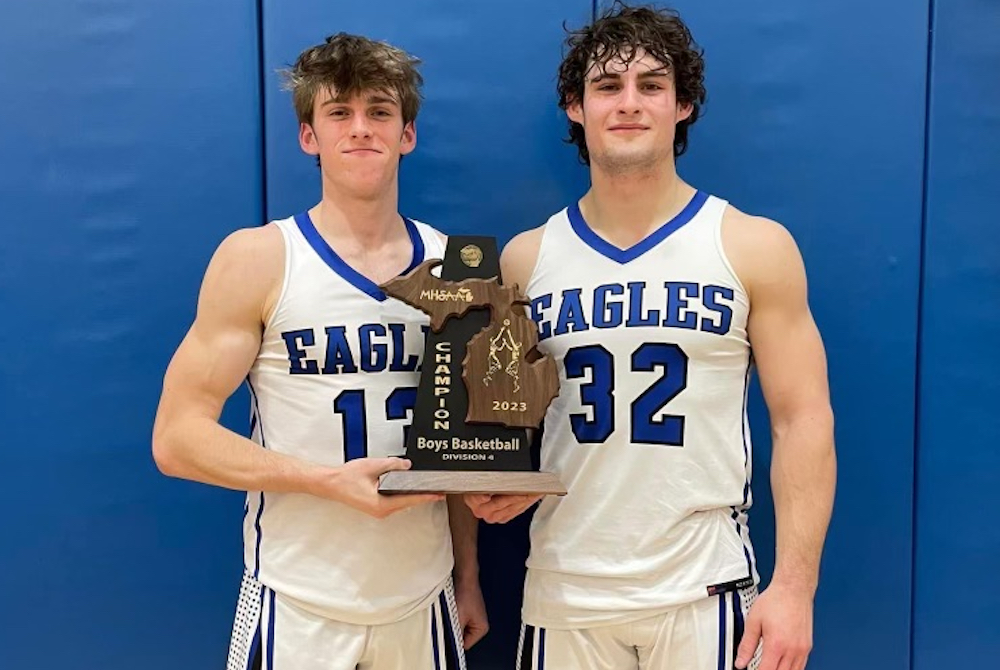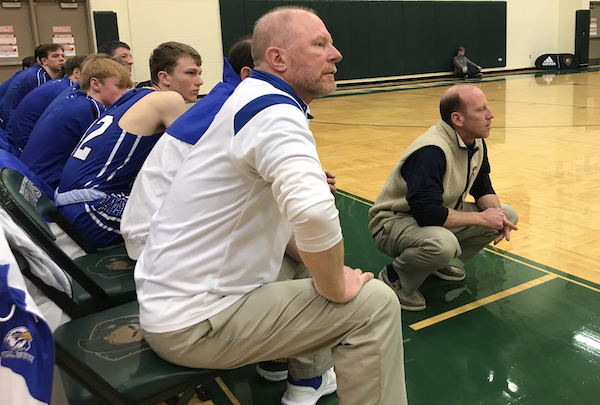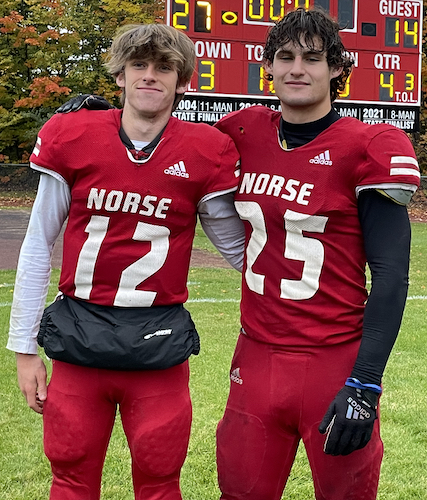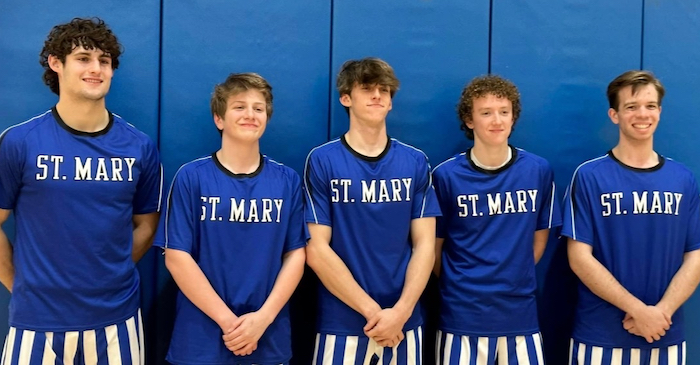
Inside Selection Sunday: Mapnalysis '18
October 21, 2018
By Geoff Kimmerly
Second Half editor
For a fading moment, we thought we saw the Big Dipper floating through the second floor of the MHSAA office Sunday morning.
Michigan’s northernmost high school in Calumet held the handle – but the only place the rest of the Region pointed was to questions about how we could come up with such a disjointed scenario for this season’s Division 6 Playoffs.
Below – as has become an annual tradition – we’ll answer that question and a few more about this year’s selection process.
Our mission Sunday was to map 213 automatic qualifiers for 11-player football – and a record 43 additional qualifiers with 5-4 or 4-4 records – plus our top 32 8-player teams across 10 divisions of playoffs that will conclude with the latter Nov. 17 at Northern Michigan University and 11-player Nov. 23-24 at Ford Field.
As often noted in the past, this process didn’t start Sunday morning – but months and in some cases more than a year ago when athletic directors began scheduling games for this fall. We make sure all are loaded into our system by early summer, and then follow every score/cancellation/forfeit/additional change through Week 9’s final games – including this season those for 46 teams from other states or Ontario that played Michigan schools and needed to be followed as well because their successes affected MHSAA teams’ strengths of schedule.
Now that the maps are drawn, we line up all that will come with the next five weeks of games including assigning officials, gathering potential Semifinal sites and continuing our work with our Finals hosts to create memorable experiences as teams play for championships.
So we’re off. For those familiar with our playoff selection process, or who have read this report in the past and don’t want a refresher on how we do what we do, skip the next section and go directly to the “Observations & Answers: 2018.” For the rest, what follows is an explanation of how we selected the playoff pairings during the morning hours Sunday, followed by how we made some of the toughest decisions plus a few thoughts on the breakdown of the field. Go to this page on MHSAA.com to see the pairings in full.
Ground Rules
Our past: The MHSAA 11-player playoff structure – with 256 teams in eight divisions, and six wins equaling an automatic berth (or five wins for teams playing eight or fewer games) – debuted in 1999. An 8-player tournament was added in 2011, and in 2017 a second division of 8-player football was introduced.
The first playoffs were conducted in 1975 with four champions. Four more football classes were added in 1990 for a total of eight champions each fall. Through 1998, only 128 teams made the postseason, based on their playoff point averages within regions (four for each class) that were drawn before the beginning of the season. The drawing of Districts and Regionals after the end of the regular season did not begin until the most recent 11-player playoff expansion.
In early years of the current process, lines were drawn by hand. Dots representing qualifying schools were pasted on maps, one map for each division, and those maps were then covered by plastic sheets. Districts and Regionals literally were drawn with dry-erase markers.
Our present: After a late Saturday night tracking scores, we file in Sunday morning for a final round of gathering results we may still need (which can include making a few early a.m. calls to athletic directors and coaches). Re-checking and triple-checking of enrollments, what schools played in co-ops and opted to play as a higher class start a week in advance, and more numbers are crunched Sunday morning as the fields are set.
As noted above, this season there were 213 automatic qualifiers for the 11-player field by win total with the final 43 additional qualifiers then selected, by playoff-point average, one from each class in order (A, B, C, D) until the field was filled. There were only five Class D additional qualifiers with 5-4 or 4-4 (playing eight games) records from which we could choose – so with those five we added 13 teams from Class A and B and 12 from Class C.
Those 256 11-player teams are then split into eight equal divisions based on enrollment, and their locations are marked on digital maps that are projected on wall-size screens and then discussed by nearly half of the MHSAA staff plus a representative from the Michigan High School Football Coaches Association. Only the locations themselves are marked (by red dots) – not records, playoff point averages or names of the schools or towns. In fact, mentions of those are strictly prohibited. Records and playoff points are not part of the criteria. Matchups, rivalries, previous playoff pairings, etc. also DO NOT come into play.
The 8-player process is different for team selection and similar for designation of Regionals. We take the top 32 teams in 8-player based on playoff point average as our field, then re-sort those 32 by enrollment – the 16 biggest make up Division 1, followed by the next 16 in Division 2. There are no automatic qualifiers by record for 8-player.
Geography rules: This long has been rule number one for drawing MHSAA brackets in any sport. Travel distance and ease DO come into play. Jumping on a major highway clearly is easier than driving across county-wide back roads, and that’s taken into consideration. Also, remember there’s only one Mackinac Bridge and hence only one way to cross between peninsulas – and boats are not considered a possible form of transportation. When opponents from both peninsulas will be in the same District, distance to the bridge is far more important than as the bird flies.
Tradition doesn’t reign: Every group of 32 (or in 8-player, 16) dots is a new group – these 32 teams have not been placed in a bracket together before. How maps have been drawn in the past isn’t considered – it’s hard to say a division has been drawn in a certain way traditionally when this set of 32 teams is making up a division for the first time.
Observations & Answers: 2018
We always start with CONGRATULATIONS: And this season they go first to Detroit Community, Detroit Public Safety Academy and Dexter, which made the MHSAA Football Playoffs for the first time. Of 611 football varsities across the state, all but 12 have made the playoffs at least once. Rockford missed out on an automatic bid with a Week 9 loss, but received an additional qualifier berth to set the record by making the MHSAA Playoffs for the 24th straight season. Crystal Falls Forest Park (22 seasons), Stevensville Lakeshore (21), Macomb Dakota (18), Climax-Scotts (16) and Grand Rapids West Catholic (16) also extended their stays on the list for longest MHSAA playoff streaks.
Break the tie: We again had to break a tie (actually two for District rounds) as teams that will or could meet ended up with the same playoff point averages. Ties are broken by head-to-head competition first – if the teams played each other during the regular season – followed by opponents’ winning percentage as the second criteria and then a coin flip if those two won’t do it. Our tie-breaks this season both took place in Division 4 – Grand Rapids South Christian received a home game against Wyoming Godwin Heights this week and St. Clair will host North Branch if they meet in a District Final. There are more possible meetings of teams with same averages in later rounds, and those ties will be broken the same way.
What is up with Division 6: Last year I had a “worst map ever,” and two of them this year would be in contention. Division 6 is the first – but the explanation for how we came up with what we did is simple. Region 1 is made up of two Districts with six schools from the northern Lower Peninsula and two from the Upper Peninsula. So however the Districts were sliced, two Lower Peninsula schools had to go with the U.P. And we settled this one strictly by comparing highway mileages of those Lower Peninsula teams to Mackinac Bridge (again, the only way to travel between the peninsulas). In the end, we placed Elk Rapids (93 miles) and Traverse City St. Francis (124) with Escanaba and Ishpeming Westwood because they are closest to the Bridge – followed by Kingsley (126), Maple City Glen Lake (144), Beaverton (161) and Tawas (168). The optics are strange – it may look like Glen Lake is driving past Elk Rapids and St. Francis on the way to Beaverton this week and potentially Tawas next. But Glen Lake’s route still travels south of those two schools this week (and depending on its chosen route on the way to Tawas as well), making everything fit – strangely looking, but nonetheless.
 Lake Huron tour: You could see most of the American side by checking out this week’s Region 2 games in 8-player Division 2. This map also looks odd – there’s a bridge crossing and a drive around Saginaw Bay. Yet, after drawing this at least two more ways, we settled here – although Region 2 looks a little odd, all four teams are east of I-75 and north of Bay City.
Lake Huron tour: You could see most of the American side by checking out this week’s Region 2 games in 8-player Division 2. This map also looks odd – there’s a bridge crossing and a drive around Saginaw Bay. Yet, after drawing this at least two more ways, we settled here – although Region 2 looks a little odd, all four teams are east of I-75 and north of Bay City.
Get your zoom on: We don’t enjoy splitting up teams that live next door to each other, but sometimes it’s a must. In Division 7 we were able to keep all eight Detroit-area and southeastern schools in Region 4, but the distance between its Districts came down to a few miles along I-96. In Division 2, we had to factor in outliers Port Huron Northern and Temperance Bedford – and the resulting Districts ended up splitting Livonia Churchill and Livonia Franklin.
At the end of the day …
I include this every year, but we draw the maps not knowing which schools are represented by the dots. At one point Sunday morning, I was wrong about which division we were considering at the time – and that’s a good thing. For the map drawing portion, it doesn’t matter.
But now that we know who is going where, here’s a glance at some stories that might emerge this week:
• We’ve got rivalries, like Portage Northern at Portage Central and Birmingham Groves at Birmingham Seaholm in Division 2, St. Johns at DeWitt and Haslett at East Lansing in Division 3, Constantine at Schoolcraft in Division 6 and Waterford Our Lady at Clarkston Everest Collegiate in Division 8 – plus Kingston at Deckerville in 8-player Division 1. There are many more we could mention – and some potential feuds renewed in two weeks as well depending on who wins this round.
• The Macomb Area Red, generally considered one of the strongest leagues annually in the state, sent four of six teams to the Division 1 playoffs – and they’re all in the same District. Champion Clinton Township Chippewa Valley (9-0) takes on Utica Eisenhower this week, and with a win would face either Macomb Dakota or Romeo after defeating both by just seven points during the regular season.
• Perhaps the most intriguing opener statewide is River Rouge (8-1) at Detroit Martin Luther King (7-2) in Division 3. Neither gets tested much during their league seasons, but both played tough nonleague opponents and the winner will be considered a favorite to make it to Ford Field.
• Farmington Hills Harrison holds the records for most MHSAA Finals appearances (18) and titles (13) and will play its final playoffs in Division 4 after finishing Division 3 runner-up a year ago. The school is closing next spring. Coach John Herrington is the winningest in state history with 441 wins and counting against only 111 losses (and a tie).
• There are a few annual powers not in the bracket this season – most notably Lowell, Muskegon Catholic Central and Menominee – and others like Rockford, Mendon and Grand Rapids West Catholic got in as additional qualifiers. West Catholic has won five straight Division 5 championships and opens at Hudsonville Unity Christian. The Falcons won the 2013 title after also entering as a 5-4 team.
• There are 34 teams entering the playoffs unbeaten, but only four Districts have multiple – Manistee and Reed City share one in Division 5, Traverse City St. Francis and Calumet in Division 6, Reading and Ottawa Lake Whiteford in Division 8, and Wyoming Tri-unity Christian and Morrice in 8-player Division 1. All of those potential matchups would happen in 11-Player District or 8-Player Regional Finals.
• This will be the eighth year of the 8-player tournament, and in Division 1 only Deckerville in 2012 has won an MHSAA championship in this format. In Division 2, reigning champion Crystal Falls Forest Park opens with 2015-16 back-to-back champion Powers North Central.
• In 8-player, three teams with 5-4 records didn’t make the field of 32, and two teams with 4-5 records advanced. This is the reality of measuring by playoff point average. Fife Lake Forest Area and Webberville are the 4-5 teams, and their opponents this season won more than 61 percent of their games. The three teams at 5-4 and one at 4-4 had opponents’ winning percentages between 38-56 percent.
Every school and every community can tell a story of making these playoffs, and over the next five weeks the fortunate will continue to write chapters filled with moments that will never be forgotten. We’re looking forward to watching them all unfold.
PHOTOS: (Top) The Division 6 map shows an odd-looking scenario with two Traverse City-area teams in the same District as two from the Upper Peninsula. (Middle) The 8-player Division 2 map shows how schools are connected to a District along the Lake Huron shoreline.

For Their Teams, For Each Other, St. Mary Seniors Team Up 2 More Times
By
Tom Spencer
Special for MHSAA.com
March 17, 2023
Shawn Bramer and Dylan Barnowski, as middle schoolers, attended the MHSAA Boys Basketball Finals every year.
 Last year, they nearly played in the Division 3 title game – falling in a Semifinal but almost making a dream come true for the then-juniors and their Lake Leelanau St. Mary coach, Matt Barnowski, also Dylan’s father.
Last year, they nearly played in the Division 3 title game – falling in a Semifinal but almost making a dream come true for the then-juniors and their Lake Leelanau St. Mary coach, Matt Barnowski, also Dylan’s father.
That dream began for some when the boys were coached by Matt as third graders, and they made serious strides last season. Before last winter, the last time the Eagles had won a Regional championship was 1950 – and no St. Mary boys basketball team had reached the Semifinals. Bramer and Dylan Barnowski – along with current seniors Jack Glynn, Drew Thompson and Nick Linguar – had high hopes of making more history this winter.
The dream ended Wednesday night with a Regional Final loss to Frankfort, which St. Mary had defeated 54-41 during the regular season. This time, the Eagles were faced with a large number of K-12 students succumbing to illness – with all five of its starters at least somewhat sick – as nearly a third of the school’s tiny enrollment was out of school the day after the loss to the Panthers.
But you won’t hear any of the players or coaches making excuses. They give all the credit to Frankfort, and they’re ready to move on. And many in the LSM family know reaching the Regional Finals this season and Breslin Center in 2022 had absolutely no probability had Bramer and Barnowski not made an iron-clad agreement last summer.
 The two friends vowed to help each other despite their personal, opposing challenges.
The two friends vowed to help each other despite their personal, opposing challenges.
Barnowski and Bramer, through LSM’s cooperative agreement with Suttons Bay, went 3-for-3 playing in 8-Player Division 1 Football Finals during their first three years of high school. But through last summer Barnowski, who quarterbacked the Norseman, had no interest in football.
Bramer, meanwhile, had been nursing a quad tendon injury since his sophomore football season and battling two bad knees but was thinking he could suffer though football and sit out the basketball season to recover. The all-state running back experienced training difficulties and even had his strength training severely hampered.
Football was king for Bramer, and he also loved basketball too. Basketball is number one to Barnowski. The longtime friends decided cut a deal to help each other — and their teammates — out.
“I was kind of on the edge,” said Bramer, who plays with braces on both knees. “After talking to each other, we both ended up just playing.
“I really shouldn’t be playing sports, but I couldn’t miss out playing with my friends,” he continued. “We just figured it was our last season so we might as well just do it.”
 Barnowski had been considering ending his football days immediately after the Norse fell short in their third-straight trip to the Finals, at Superior Dome in Marquette in Fall 2021. That loss was at the hands of Adrian Lenawee Christian 31-20.
Barnowski had been considering ending his football days immediately after the Norse fell short in their third-straight trip to the Finals, at Superior Dome in Marquette in Fall 2021. That loss was at the hands of Adrian Lenawee Christian 31-20.
The Norseman graduated most of their offensive and defense lines last spring and expected to be small in numbers. Until this fall, they had lost only one regular-season game on their way to three straight title game appearances. This year they finished 3-5.
The big linemen losses — Barnowski’s protection — was forcing him to weigh his injury risk against having a senior basketball season.
“We did it for each other,” Barnowski said. “I talked with Shawn, and we knew we had a big community behind us and it would be hard for them if we just quit.
“I knew we weren’t going to have the same powerhouse team we had,” he continued. “We weren’t very good this year, but we still had a blast.”
This week’s loss put an end to the possible Breslin championship finish, but it left the friends happy with the decision to play both sports. The Eagles finished 20-4.
Barnowski led St. Mary in scoring. He averaged better than 20 points a game with more than seven rebounds and five assists. Bramer averaged just under 15 points per game, and almost 10 rebounds.
The two big men each scored 11 in the season-ending loss. Thompson scored 14. This year’s senior-dominated team likely will be remembered for its basketball success for some time. Barnowski, Bramer and Glynn experienced only one loss in District play over their four seasons.
“It’s a really special groups of kids,” Coach Barnowski said. “These kids kind of transformed St. Mary’s basketball.
 “They’ve really built the program,” he continued. “It’s been a roller coaster ride.”
“They’ve really built the program,” he continued. “It’s been a roller coaster ride.”
Bramer and Dylan Barnowski also played baseball in the past for the Eagles, but that likely won’t happen this spring. Barnowski plans to golf, and Bramer expects to sit the spring season out and heal.
“We’ll never forget these last four years of varsity we played,” Barnowski said. “I‘ve decided to go a more relaxing route, and I’m going for some golf.”
With their Breslin dream over, the friends are ready to enjoy the St. Mary’s community support and move on. They’re bummed so many were sick in the end but won’t use it as an excuse.
“Hats off to Frankfort,” Barnowski said. “They did an incredible job of shutting us down.”
Bramer agreed.
“They just played their game better than we did,” he said. “They took the lead at the end of the third quarter, and it was a battle from there.”
 Tom Spencer is a longtime MHSAA-registered basketball and soccer official, and former softball and baseball official, and he also has coached in the northern Lower Peninsula area. He previously has written for the Saginaw News, Bay County Sports Page and Midland Daily News. He can be reached at [email protected] with story ideas for Manistee, Wexford, Missaukee, Roscommon, Ogemaw, Iosco, Alcona, Oscoda, Crawford, Kalkaska, Grand Traverse, Benzie, Leelanau, Antrim, Otsego, Montmorency, Alpena, Presque Isle, Cheboygan, Charlevoix and Emmet counties.
Tom Spencer is a longtime MHSAA-registered basketball and soccer official, and former softball and baseball official, and he also has coached in the northern Lower Peninsula area. He previously has written for the Saginaw News, Bay County Sports Page and Midland Daily News. He can be reached at [email protected] with story ideas for Manistee, Wexford, Missaukee, Roscommon, Ogemaw, Iosco, Alcona, Oscoda, Crawford, Kalkaska, Grand Traverse, Benzie, Leelanau, Antrim, Otsego, Montmorency, Alpena, Presque Isle, Cheboygan, Charlevoix and Emmet counties.
PHOTOS (Top) St. Mary’s seniors Dylan Barnowski, left, and Shawn Bramer hold up the team’s District championship trophy last week. (2) Eagles coach Matt Barnowski, center, and assistant Sander Scott coach up their team during last week’s Regional Semifinal win over Mesick. (3) Dylan Barnowski and Bramer also teamed up during successful football careers. (4) St. Mary’s seniors, from left: Shawn Bramer, Jack Glynn, Dylan Barnowski, Drew Thompson and Nick Linguar. (Sideline photo by Tom Spencer; player photos by Emmerson Lamb Photography.)

